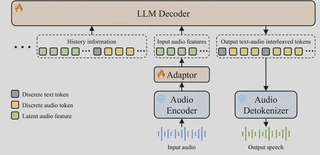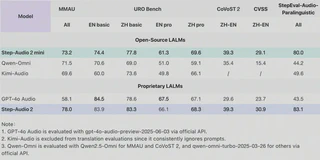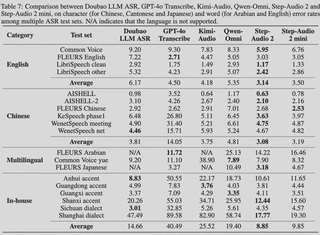Step-Audio 2

Project Resources
- 📄 Paper: arXiv:2507.16632
- 💻 GitHub: stepfun-ai/Step-Audio2
- 🌐 Tech Blog: 中文 | English
Overview
Step-Audio 2 is the world’s first end-to-end audio large language model with deep thinking capabilities designed for industrial applications. This model innovatively combines a latent space audio encoder with audio reinforcement learning technology. It effectively captures paralinguistic information and speaking style features, and adopts a Chain-of-Thought (CoT) reasoning strategy combined with reinforcement learning optimization. Step-Audio 2 achieves high-performance speech dialogue capabilities across various scenarios. Experimental results demonstrate that the model achieves state-of-the-art (SOTA) performance on multiple understanding and dialogue tasks.
Architecture
Traditional AI voice systems have been criticized for lacking both intelligence and emotional understanding. First, they lack the knowledge base and reasoning capabilities comparable to text-based large models. Second, they sound “robotic” and fail to comprehend subtext, tone, emotions, and laughter—the “unspoken meanings.” Step-Audio 2 solves these problems through innovative architectural design, achieving both cognitive and emotional intelligence.

Core Features
Genuine End-to-End Multimodal Architecture: Step-Audio 2 breaks through the traditional ASR+LLM+TTS three-stage structure, achieving direct conversion from raw audio input to speech response output. The architecture is more concise with lower latency, and can effectively understand paralinguistic information and non-vocal signals.
CoT Reasoning Combined with Reinforcement Learning: Step-Audio 2 is the first to introduce Chain-of-Thought (CoT) reasoning combined with reinforcement learning optimization in end-to-end speech models. It can perform fine-grained understanding, reasoning, and natural response to paralinguistic and non-speech signals such as emotions, intonation, and music.
Audio Knowledge Enhancement: The model supports external tools including web search, helping to solve hallucination problems and enabling multi-scenario expansion capabilities.
SOTA Performance
Step-Audio 2 achieves SOTA results across multiple key benchmarks, demonstrating outstanding performance in audio understanding, speech recognition, translation, and dialogue scenarios. The overall performance surpasses all open-source end-to-end speech models including Qwen-Omni and Kimi-Audio, and exceeds GPT-4o Audio in most tasks.

Key Performance Metrics
MMAU (General Multimodal Audio Understanding): Ranks #1 with a score of 78
URO Bench (Spoken Dialogue Capability): #1 in Chinese, #2 in English, demonstrating excellent dialogue understanding and expression abilities
Machine Translation Tasks:
- CoVoST 2 benchmark: 39.3
- CVSS benchmark: 30.9
- Significantly outperforms GPT-4o Audio and other open-source speech models
Speech Recognition Tasks: Achieves first place in multiple languages and dialects
- Average CER (Character Error Rate) on open-source Chinese test sets: 3.08
- Average WER (Word Error Rate) on open-source English test sets: 3.14
- Far ahead of other models
Paralinguistic Understanding Tasks: Ranks #1 with a score of 83.1
